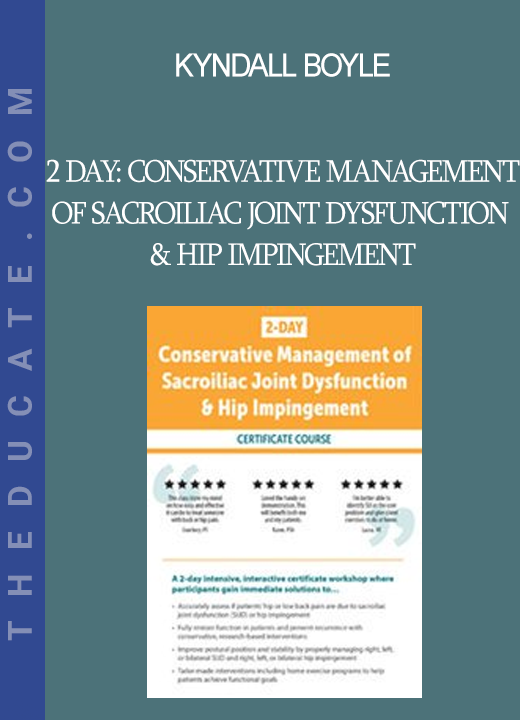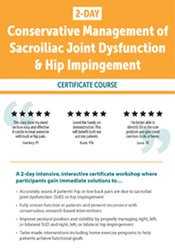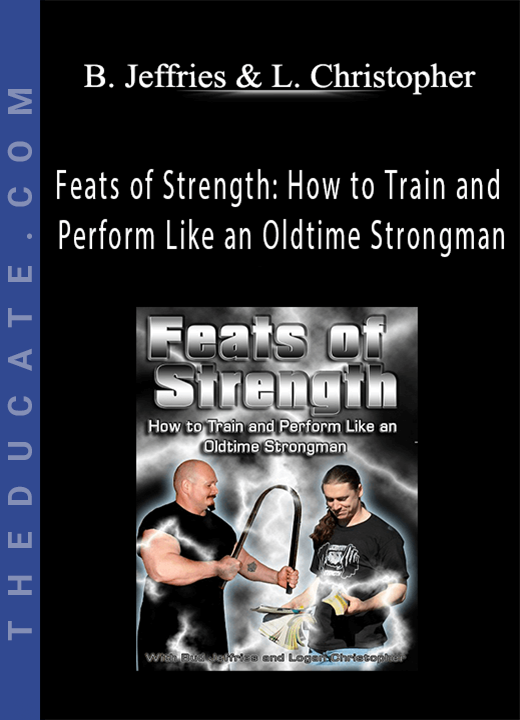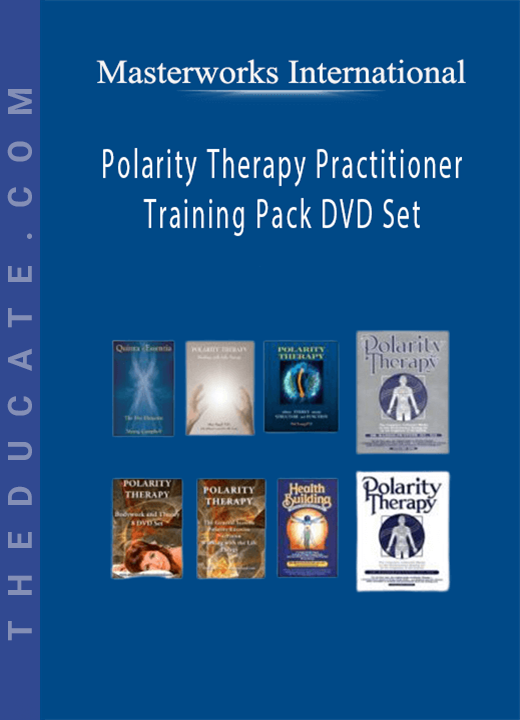Description
Kyndall Boyle – 2 DAY: Conservative Management of Sacroiliac Joint Dysfunction & Hip Impingement
- Faculty:
- Kyndall Boyle
- Duration:
- 12 Hours 18 Minutes
- Format:
- Audio and Video
- Copyright:
- Jan 24, 2018
Description
The National Institutes of Health states that millions of Americans spend at least $50 billion a year to alleviate the stress and discomfort in their low back. A common, yet enigmatic cause of this debilitating pain is the malalignment of the sacroiliac joint (SIJ). At first glance, however, many rehab professionals and even surgeons believe other back and hip injuries, such as facet-joint syndrome or a bulging disc, are the reasons for the pain. X-rays, MRIs, and even CT scans might show narrowing spinal discs or other possible factors producing the problem; yet these tests have minimal benefit because they oftentimes fail to show the exact source of the client’s pain.
It is important to accurately identify and diagnose pain from the SIJ’s and pain from hip impingement. Medical professionals may misdiagnose the problem and intervention may be unsuccessful. In some cases, surgery is performed unnecessarily. In order to help restore and prevent future pain in patients, rehab professionals need the proper tools to accurately identify both SIJD and Hip Impingement to manage them appropriately.
In this comprehensive online program, participants gain the tools to assess and treat patients with SIJD and/or hip impingement. Kyndall Boyle, PT, PhD, OCS, PRC, who has nearly 25 years of experience as a clinician and researcher, shares the latest evidence in the field, along with rationale for conservative intervention. She discusses relevant anatomy and biomechanics, including issues of bilateral and unilateral instability and postural asymmetry, as well as examines the relationship between SIJD and hip impingement, and the relationship between SIJD, suboptimal respiration, posture, and motor control.
You’ll immediately take home the knowledge needed to assess and treat SIJD by examining a case study, case series, and a randomized controlled trial. During the interactive lab portion of the class, participants expand their hands-on skills by watching demonstrational therapeutic exercises to manage SIJD and hip impingement.
Handouts
| Manual – Conservative Management of Sacroiliac Joint Dysfunction (31.32 MB) | 184 Pages | Available after Purchase |
Outline
SACROILIAC JOINT DYSFUNCTION (SIJD): HOW TO EXAMINE AND IDENTIFY
- Terminology and prevalence
- Signs and symptoms suggesting SIJD
- Examination tests and measures to identify SIJD
- Examination tests and measures to identify postural patterns
ANATOMY AND BIOMECHANICS OF SIJD
- Relationship between faulty respiration, posture, motor control, and SIJD
- Right vs. left SIJ movement
- Relationship between hips and SIJ
- Human asymmetry/movement patterns and the influence on SIJD
CONSERVATIVE INTERVENTIONS USED TO MANAGE SIJD
- Current research/literature evidence
- Case study
- Case series
- Randomized control trial
- Clinical suggestion
- Book chapter
HANDS-ON LAB/DEMONSTRATION
- Demonstration/Lab practice of examination tests and measures
- Demonstration/Lab practice of therapeutic exercises for right SIJD
- Demonstration/Lab practice of therapeutic exercises for left SIJD
- Demonstration/Lab practice of therapeutic exercises for symmetrical postural pattern (bilateral or unilateral SIJD)
HIP IMPINGEMENT: HOW TO EXAMINE AND IDENTIFY
- Terminology and prevalence
- Signs and symptoms suggesting hip impingement
- Examination tests and measures to identify hip impingement
- Examination tests and measures to identify postural patterns
ANATOMY AND BIOMECHANICS OF HIP IMPINGEMENT
- Relationship between SIJD and hip impingement
- Relationship between faulty respiration, posture, motor control, and SIJD
- Right vs. left SIJ movement
- Human asymmetry/movement patterns and the influence on hip impingement
CONSERVATIVE INTERVENTIONS USED TO MANAGE HIP IMPINGEMENT
- Current research/literature evidence
- Case study
- Case series
- Randomized control trial
- Clinical suggestion
- Book chapter
- HANDS-ON LAB/DEMONSTRATION
- Demonstration/Lab practice of examination tests and measures
- Demonstration/Lab practice of therapeutic exercises for hip impingement
- Demonstration/Lab practice of therapeutic exercises for symmetrical postural pattern
Faculty

Kyndall Boyle, PT, PhD, OCS, PRC Related seminars and products: 3
Kyndall Boyle, PT, PhD, OCS, PRC, is a licensed physical therapist who has worked in a variety of settings for the past 25 years: outpatient orthopedic, sports medicine, home health, skilled nursing, and acute care. Dr. Boyle is currently the Director and Owner of OPTimal Performance Physical Therapy in Boone, NC. In addition to the clinic, she served as a full-time faculty member for Doctor of Physical Therapy programs for 14 years. Dr. Boyle earned her BS in PT from the University of New Mexico, an MS from the UNC at Chapel Hill, and a PhD from Nova Southeastern University in Fort Lauderdale, FL. She is currently Board Certified in Orthopedics having earned her designation as an Orthopedic Clinical Specialist (OCS).
In addition, Dr. Boyle studied Postural Restoration Concepts that later led to her certification (PRC). Because of her clinical experience, she has authored numerous peer-reviewed articles, abstracts, book chapters, and magazine articles. Dr. Boyle continues to be active in research relating to the management of musculoskeletal conditions.
Speaker Disclosures:
Financial: Kyndall Boyle is director and owner of OPTimal Performance Physical Therapy. She receives a speaking honorarium from PESI, Inc.
Non-financial: Kyndall Boyle has no relevant non-financial relationship to disclose.







Reviews
There are no reviews yet.